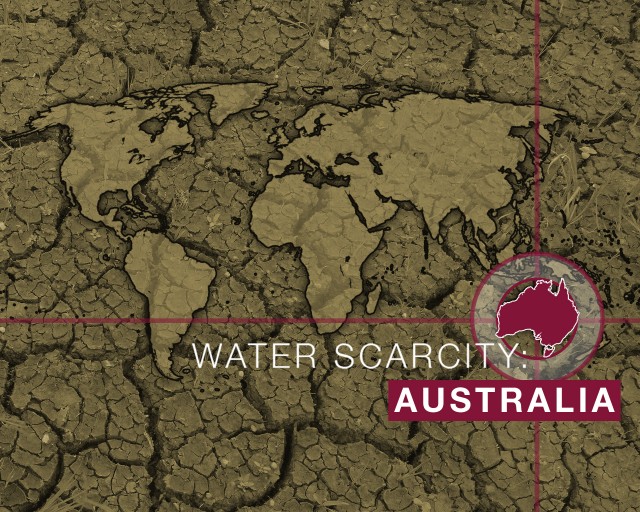The world could suffer a 40 percent shortfall in water in just 15 years unless countries dramatically change their use of the resource, a U.N. report warned last week.
Many underground water reserves are already running low, while rainfall patterns are predicted to become more erratic with climate change. As the world’s population grows to an expected 9 billion by 2050, more groundwater will be needed for farming, industry and personal consumption.
The report predicts global water demand will increase 55 percent by 2050, while reserves dwindle. If current usage trends don’t change, the world will have only 60 percent of the water it needs in 2030, it said.
Having less available water risks catastrophe on many fronts: crops could fail, ecosystems could break down, industries could collapse, disease and poverty could worsen, and violent conflicts over access to water could become more frequent.
“Unless the balance between demand and finite supplies is restored, the world will face an increasingly severe global water deficit,” the annual World Water Development Report said, noting that more efficient use could guarantee enough supply in the future.
The report, released in New Delhi two days before World Water Day, calls on policymakers and communities to rethink water policies, urging more conservation as well as recycling of wastewater as is done in Singapore. Countries may also want to consider raising prices for water, as well as searching for ways to make water-intensive sectors more efficient and less polluting, it said.
Unregulated use
In many countries including India, water use is largely unregulated and often wasteful. Pollution of water is often ignored and unpunished. At least 80 percent of India’s population relies on groundwater for drinking to avoid bacteria-infested surface waters.
In agriculture-intense India, where studies show some aquifers are being depleted at the world’s fastest rates, the shortfall has been forecast at 50 percent or even higher. Climate change is expected to make the situation worse, as higher temperatures and more erratic weather patterns could disrupt rainfall.
Currently, about 748 million people worldwide have poor access to clean drinking water, the report said, cautioning that economic growth alone is not the solution — and could make the situation worse unless reforms ensure more efficiency and less pollution.
“Unsustainable development pathways and governance failures have affected the quality and availability of water resources, compromising their capacity to generate social and economic benefits,” it said. “Economic growth itself is not a guarantee for wider social progress.”
Here is just one example of what is happening around the world
China’s Appetite Will Strain Australia’s Water
Summary
Editor’s Note: This is the ninth installment of an occasional series on water scarcity issues around the world that Stratfor will be building upon periodically.
In the coming decades, Australia’s water resources will be stretched not only by climate and domestic consumption but also through export. Australia will not physically export water; rather, it will virtually export water through its agricultural exports, mostly to China. Consumption shifts in China, a free trade agreement between Canberra and Beijing, and increased Chinese investment in foreign agricultural activities will drive up agricultural trade between China and Australia.
Australia, already the driest inhabited continent, is expected to experience more extreme droughts in the future, making water a precious commodity. A small overall population and progressive water regulations in basins already experiencing water stress will mitigate the impact, but Australia’s role as a virtual water exporter will partially reverse efforts to avoid increased water stress.
Analysis
Despite the arid climate in much of the country, Australia’s per capita water availability is high, at 21,077 cubic meters per year, though this availability is not evenly distributed. For a developed nation, Australia’s water withdrawals for agriculture are high, with agricultural activity accounting for roughly 74 percent of the country’s total withdrawals of the nearly 23 billion cubic meters per year. Comparatively, in the United States, another large developed agricultural producer, agricultural water withdrawals are only 40 percent of the roughly 478 billion cubic meters used annually, though Australia and the United States have high per capita water use at roughly 1,200 and 1,600 cubic meters per year, respectfully.
Australia uses more water for agriculture as a percentage of total water use than other developed countries, but it does so with comparative efficiency. It uses less water than less developed countries that require large amounts of irrigation to support their agricultural industries. For example, in Uzbekistan, an economy reliant on irrigated crops, withdrawals are 56 billion cubic meters per year, 90 percent of which go toward agriculture. In Pakistan, the total volume nears 184 billion cubic meters per year, and 94 percent of that is used by the agricultural sector. Australia’s low population reduces stress from domestic consumption. However, areas that have larger amounts of agricultural activity are under greater stress in terms of sustainable water use, regardless of their comparative aridness. The Murray-Darling Basin in Australia’s southeast is a prime example of both the stress agriculture places on Australia’s resources and the proactive solutions Canberra has begun taking to address the issue.

Australia’s Mitigation Efforts
The Murray-Darling Basin accounts for more than 40 percent of Australia’s agricultural production by value (together, New South Wales and Victoria, which span the basin, produce 48 percent of the country’s corn, 31 percent of beef, 43 percent of wheat and 75 percent of dairy cattle production). Available water resources are very stressed. Groundwater began to strain as early as the mid-1990s and worsened during a severe drought between 2001 and 2007. Almost all of the rivers in the basin show evidence of environmental degradation, and one-third of the rivers have been substantially modified.

Australia has already recognized the problem of inefficient, sometimes unregulated overuse of both surface and groundwater in the region, and adjustments in water policy seek to improve water security in the basin through cooperative management of available resources. More than a decade ago, Australia established the National Water Initiative as a blueprint for water reform. The initiative is tasked with, among other things, addressing overallocation on stressed systems and improving pricing. Each state or territory government is responsible for establishing an implementation plan. Though Australia has not yet achieved the full goal of the program — economic, efficient and sustainable water management for the whole country — acknowledgement of the problem and a cohesive policy on water governance is one of the necessary steps. Australia’s focus on the need for good data and monitoring is also promising for the future of efficient water management, because accurate data is essential to proper management of water resources.
States within the Murray-Darling Basin also have a variety of trading rules under which irrigators can buy and sell water allocations and entitlements as needed. In July 2014, the Murray-Darling Basin Authority implemented trading rules between states. Water trading is meant to improve the economic use of water, encouraging water use for higher-value goods and less water-intensive crops. However, staple crops could suffer under this arrangement.
China’s Food Security Needs
While the physical water trading schemes in the Murray-Darling Basin are on the forefront of new water policies in Australia, Canberra has, in a sense, been trading water with other countries as long as it has been a commodities exporter. Under the concept of virtual water balance, water that is used to produce an exported good is traded to the importing nation. Commodity exporting countries, such as Australia, are virtual water exporters, while importing countries or regions, such as Japan or the Middle East, are virtual water importers. By virtue of this balance, Australian water will be supporting not only the domestic population but Australia’s trading partners as well.

Even with slowing economic growth, China is already the destination for roughly one-third of Australia’s exports. With the conclusion of negotiations over a free trade agreement between the countries in November 2014 and the “most favored nation” clause secured March 13, this relationship is expected to grow. One specific water-intensive area where the relationship will be important is in the agricultural sector. The free trade agreement phases out tariffs on a number of agricultural goods. The removal of both beef and dairy tariffs — higher-value agricultural commodities that will see higher consumption rates as dietary patterns in China continue to shift — will give Australia another advantage over its competitors, in addition to its geographic proximity. However, it will also put an additional burden on Canberra’s water resources.
Moreover, China will likely take a multipronged approach to ensuring food security — one that probably will involve investing abroad in land resources and agricultural industries. China’s increasing pursuit of agricultural lands in other countries could create friction between the opposing desires for resource nationalism and for Chinese investment and consumption. Australia will be no exception.
In terms of land, the Northern Territory and Queensland are the two regions that have the highest percentages and highest absolute volume of foreign-owned land in Australia. Operations in these areas, except for a small portion of southern Queensland, would not use water resources from the Murray-Darling Basin. Still, Australia’s water regulations will help these other regions manage the additional water stress by any increase in demand. The subsector of beef cattle has been a focus of foreign involvement, in terms of both the number of investments and total acreage dedicated. Australia already exports roughly 70 percent of its beef and veal production, and with foreign investment from agriculture expected to increase in the future, this sector will continue contributing to Australia’s virtual water trade.
China has already invested more than $4 billion in Australia’s agricultural business, including sugar mills, seed companies and grocery distributors, since 2007. China is not the only foreign investor in Australian agriculture, but we expect Chinese interest to remain steady or increase as land and water resources in China become scarcer and Beijing resorts to alternative means to maintain food security. The free trade agreement will also make it more economical for Chinese farmers and herders (or related corporations) operating in Australia to export goods back into China.
Australia’s water resources will be tested over the coming years. Drought conditions are expected to become more prevalent, making efficient and economic use of available water resources even more important to Australia’s agriculture sector. These water resources not only will support the relatively small population of Australia but also will be exported virtually in the form of agricultural goods. China will be one of the primary beneficiaries of this trade, buoyed by the new free trade agreement. Australia is poised to benefit from this relationship, but it will have to continue with water management efforts in order to mitigate the extra water stress that increased agricultural trade will bring.
- Part 1: Yemen’s Looming Water Crisis
- Part 2: U.S. Agriculture Wilts During California’s Drought
- Part 3: South Africa’s Water Needs Will Be Costly
- Part 4: Indonesia’s Disjointed Islands Make Water Scarcity a Problem
- Part 5: Mesopotamian Vitality Falls to Turkey
- Part 6: Water Use Reform Will Be Difficult for Fractured India
- Part 7: Sao Paulo Drought Could Benefit Brazil
- Part 8: Industrial Expansion Will Strain Mexico’s Water Resources

